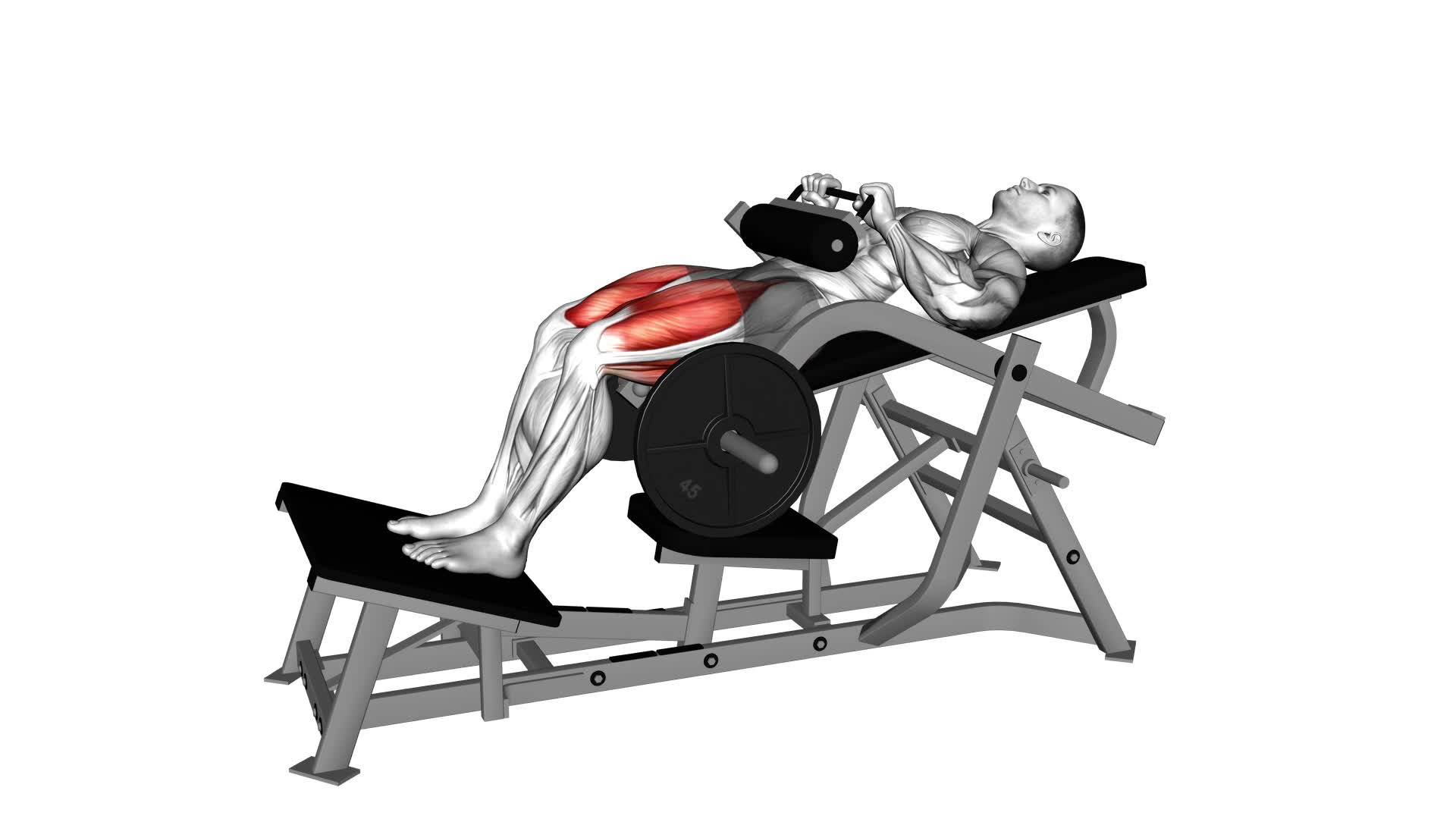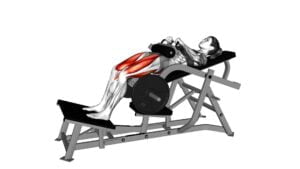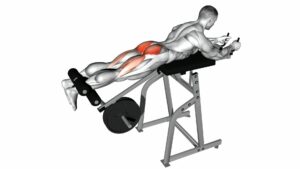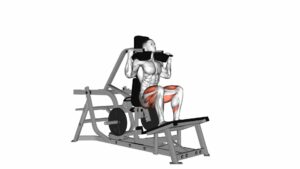Lever Hip Thrust (Plate Loaded) (Male) – Video Exercise Guide & Tips

In this video exercise guide, you'll learn how to properly perform the Lever Hip Thrust (Plate Loaded) as a male. This exercise targets your glutes and hamstrings, helping you build strength and power in your lower body.
Watch This Exercise Video
Follow along step-by-step to ensure correct set-up and positioning. Avoid common mistakes, increase intensity, and progress safely with our expert tips.
Get ready to take your hip thrusts to the next level!
Key Takeaways
- Lever Hip Thrust (Plate Loaded) is an effective exercise for improving lower body strength and muscle activation.
- It specifically targets the glutes and hamstrings, leading to increased glute activation and overall lower body development.
- The exercise allows for resistance and muscle challenge with weighted plates, providing variations and modifications for different fitness levels and goals.
- Proper form and positioning, including correct foot placement and maintaining a neutral spine, are crucial for maximizing the effectiveness of the exercise.
Benefits of Lever Hip Thrust (Plate Loaded)
You will experience significant improvements in lower body strength and muscle activation with the Lever Hip Thrust (Plate Loaded) exercise. This exercise is highly effective in targeting the glutes and hamstrings, leading to increased glute activation and overall lower body development. By loading the hips with plates, you can add resistance and challenge your muscles even further.
One of the key benefits of the Lever Hip Thrust (Plate Loaded) exercise is its ability to activate the glute muscles to a greater extent than other lower body exercises. This is essential for individuals looking to strengthen and tone their glutes. The exercise specifically targets the gluteus maximus, which is the largest muscle in the buttocks.
Moreover, the Lever Hip Thrust (Plate Loaded) exercise offers various variations and modifications to cater to different fitness levels and goals. You can adjust the weight of the plates, the range of motion, or even incorporate single-leg variations to further challenge your muscles. These variations allow you to continuously progress and avoid plateaus in your training.
Proper Set-Up and Positioning
To ensure optimal hip alignment during the lever hip thrust exercise, it's important to set up properly.
Begin by placing your feet shoulder-width apart and flat on the ground, ensuring they're positioned correctly to provide stability and support.
This will help maintain proper form and maximize the effectiveness of the exercise.
Optimal Hip Alignment
Achieving proper hip alignment is essential for performing the lever hip thrust exercise effectively and safely.
To ensure optimal hip alignment, start by positioning your body correctly on the lever hip thrust machine. Sit on the machine with your back against the pad and your feet flat on the foot platform. Adjust the foot platform so that it aligns with the middle of your heels. This position will allow for proper force distribution and engagement of the glute muscles.
Additionally, maintaining a neutral spine throughout the exercise is crucial for optimal hip alignment. Avoid overarching or rounding your lower back, as this can put unnecessary stress on the spine.
Correct Foot Placement
Maintaining proper foot placement is crucial for ensuring correct set-up and positioning during the lever hip thrust exercise. To achieve optimal results, it's important to understand the various foot placement variations and advanced hip thrust techniques.
When performing the lever hip thrust, start by placing your feet shoulder-width apart, ensuring that your heels are firmly planted on the ground. This position provides a stable base and allows for maximum force production.
For advanced variations, you can experiment with a wider or narrower stance to target different muscle groups. Additionally, you can try elevating your feet on a block or platform to increase the range of motion and engage your glutes even more.
Remember to maintain proper form and alignment throughout the exercise to maximize its effectiveness and prevent injury.
Step-by-Step Guide to Performing the Exercise
Now let's focus on the points that will help you perform the lever hip thrust exercise correctly and avoid common mistakes.
By following this step-by-step guide, you'll be able to maximize the benefits of proper form, including increased glute activation and improved hip strength.
Paying attention to these details will ensure you get the most out of this exercise and minimize the risk of injury.
Common Mistakes to Avoid
To perform the Lever Hip Thrust (Plate Loaded) exercise correctly, start by positioning yourself properly on the lever machine.
Common mistakes to avoid during this exercise include:
- Improper foot placement: Ensure that your feet are flat on the foot platform and hip-width apart. Avoid pointing your toes outward or inward, as this can lead to imbalances and decreased effectiveness of the exercise.
- Arching your back: Maintain a neutral spine throughout the movement. Avoid excessive arching or rounding of the lower back, as this can put unnecessary stress on the spine and lead to injury.
- Using too much weight: Start with a lighter weight and gradually increase as you become more comfortable with the exercise. Using too much weight can compromise your form and increase the risk of injury.
- Neglecting the glute squeeze: At the top of the movement, make sure to squeeze your glutes for maximum activation. Neglecting this important step can limit the effectiveness of the exercise.
Benefits of Proper Form
Proper form during the Lever Hip Thrust (Plate Loaded) exercise enhances its effectiveness and reduces the risk of injury. The importance of technique can't be overstated when performing this exercise. By maintaining the correct form, you ensure that the targeted muscles are being activated properly. This leads to better muscle activation and engagement, which in turn helps you achieve better results.
Proper form also helps to minimize the risk of strain or injury to the lower back and hips, which are vulnerable areas during this exercise. By following a step-by-step guide and focusing on maintaining the correct form, you can maximize the benefits of the Lever Hip Thrust.
Now, let's explore some common mistakes to avoid in order to further improve your performance and safety.
Common Mistakes to Avoid
One common mistake to avoid when performing the lever hip thrust exercise is overextending your lower back. Overextending the lower back can lead to strain and potential injury. To ensure proper form and maximize the effectiveness of the exercise, follow these technique tips:
- Maintain a neutral spine: Keep your back in a neutral position throughout the movement. Avoid excessive arching or rounding of the lower back.
- Engage your glutes: Focus on squeezing your glutes as you lift your hips off the ground. This will help activate the correct muscles and prevent compensations from other muscle groups.
- Use a controlled tempo: Avoid using momentum to thrust your hips upward. Instead, perform the movement in a slow and controlled manner, focusing on the contraction of your glutes.
- Position your feet correctly: Place your feet hip-width apart and make sure they're firmly planted on the ground. This will provide a stable base of support and help maintain proper alignment.
By avoiding these common mistakes and following these technique tips, you can perform the lever hip thrust exercise safely and effectively.
Remember to always listen to your body and consult with a fitness professional if you have any concerns or questions.
Tips for Increasing Intensity and Progression
How can you increase the intensity and progression of the lever hip thrust exercise?
There are a few strategies you can employ to challenge yourself and continue making progress with this exercise.
One way to increase the intensity is by adding resistance. You can do this by placing a weight plate on your lap or using a barbell across your hips. Gradually increase the weight as you get stronger to keep pushing your limits.
Another tip is to incorporate advanced variations of the lever hip thrust. This can include single-leg or staggered stance hip thrusts, which require more stability and engage different muscle groups.
You can also try elevating your feet on a bench or adding a resistance band around your thighs to further intensify the exercise.
It's important to remember to maintain proper form and technique throughout these progressions, so start with lighter weights or modifications and gradually work your way up.
With consistency and dedication, you can continue challenging yourself and making progress with the lever hip thrust exercise.
Safety Precautions and Modifications
To ensure your safety and make necessary modifications, it's important to consider certain precautions when performing the lever hip thrust exercise. Here are some safety modifications and injury prevention tips to keep in mind:
- Warm-up: Prior to starting the lever hip thrust, it's crucial to warm up your glutes, hamstrings, and lower back muscles. This can be done through dynamic stretches or light cardio exercises.
- Proper form: Maintain proper form throughout the exercise by keeping your back straight, shoulders relaxed, and core engaged. Avoid arching your back or allowing your knees to collapse inward.
- Start with lighter weights: If you're new to this exercise or recovering from an injury, start with lighter weights and gradually increase the load as you build strength and confidence.
- Use a spotter: When performing the lever hip thrust with heavy weights, it's advisable to have a spotter present to ensure your safety and provide assistance if needed.
By implementing these safety modifications and following proper technique, you can greatly reduce the risk of injury and maximize the effectiveness of the lever hip thrust exercise.
Remember to listen to your body and consult with a fitness professional if you have any concerns or questions.
Frequently Asked Questions
What Is the Recommended Weight Range for Beginners When Performing the Lever Hip Thrust Exercise?
When starting the lever hip thrust exercise, it's important for beginners to choose a weight that challenges them but allows for proper form. The recommended weight range varies depending on your individual strength and fitness level.
It's always a good idea to start with a lighter weight and gradually increase as you become more comfortable and confident with the movement.
Additionally, if you don't have access to a plate loaded machine, there are variations of the exercise that can be done without it.
Can the Lever Hip Thrust Exercise Be Performed Without Using a Plate-Loaded Machine?
To perform the lever hip thrust exercise without using a plate-loaded machine, there are alternative variations you can try. These variations include using resistance bands, dumbbells, or even bodyweight.
The benefits of doing the exercise without equipment include increased stability and the ability to do it anywhere. However, keep in mind that using a plate-loaded machine allows for more precise weight adjustments and may provide a higher level of resistance for advanced trainees.
How Often Should the Lever Hip Thrust Exercise Be Incorporated Into a Workout Routine?
To get the most out of the lever hip thrust exercise, it's important to know how often to do it and the benefits it provides.
The lever hip thrust is a great way to target your glutes and hamstrings, helping to strengthen and tone these muscles. Incorporating this exercise into your workout routine 2-3 times a week can help you see improvements in your lower body strength and overall physique.
Don't forget to warm up properly and listen to your body's limits.
Are There Any Specific Muscle Groups That the Lever Hip Thrust Exercise Targets?
The lever hip thrust exercise targets specific muscle groups and offers several benefits. By engaging your glutes, hamstrings, and quadriceps, this exercise helps to strengthen and tone your lower body. Additionally, it can improve hip mobility and stability, enhance athletic performance, and contribute to better posture.
Incorporating the lever hip thrust exercise into your workout routine can be an effective way to target these specific muscle groups and experience the associated benefits.
Is It Necessary to Warm up Before Performing the Lever Hip Thrust Exercise, and if So, What Are Some Recommended Warm-Up Exercises?
Before performing the lever hip thrust exercise, it's important to warm up to prevent injury and maximize the benefits. Warming up can increase blood flow and prepare your muscles for the workout.
Some recommended warm-up exercises include dynamic stretches, such as leg swings and hip circles, as well as light cardio exercises like jogging or cycling.
Conclusion
In conclusion, the lever hip thrust (plate loaded) is a highly effective exercise for targeting the glutes and hamstrings. By following the proper set-up and positioning, performing the exercise step-by-step, and avoiding common mistakes, you can optimize your results.
Remember to increase intensity gradually and prioritize safety by using proper form and modifications when necessary. Incorporating this exercise into your routine will help you build strength and improve your overall lower body performance.

Author
Years ago, the spark of my life’s passion ignited in my mind the moment I stepped into the local gym for the first time. The inaugural bead of perspiration, the initial endeavor, the very first surge of endorphins, and a sense of pride that washed over me post-workout marked the beginning of my deep-seated interest in strength sports, fitness, and sports nutrition. This very curiosity blossomed rapidly into a profound fascination, propelling me to earn a Master’s degree in Physical Education from the Academy of Physical Education in Krakow, followed by a Sports Manager diploma from the Jagiellonian University. My journey of growth led me to gain more specialized qualifications, such as being a certified personal trainer with a focus on sports dietetics, a lifeguard, and an instructor for wellness and corrective gymnastics. Theoretical knowledge paired seamlessly with practical experience, reinforcing my belief that the transformation of individuals under my guidance was also a reflection of my personal growth. This belief holds true even today. Each day, I strive to push the boundaries and explore new realms. These realms gently elevate me to greater heights. The unique combination of passion for my field and the continuous quest for growth fuels my drive to break new ground.







